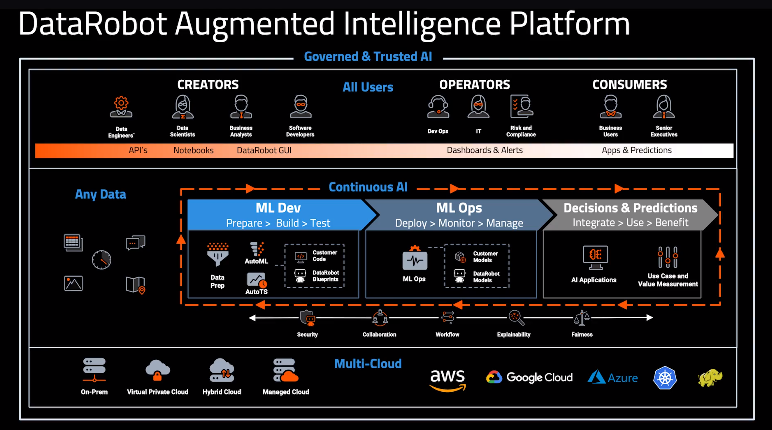DataRobot is revolutionizing predictive analytics with its comprehensive automated machine learning (AutoML) platform. Designed for businesses across industries like finance, healthcare, retail, and beyond, DataRobot empowers organizations to unlock actionable insights from their data. This in-depth DataRobot review covers its core features, use cases, benefits, challenges, and competitor comparisons to help you decide if DataRobot is the right tool for your needs.

Overview of DataRobot Review
Founded in 2012, DataRobot aims to democratize AI by making machine learning accessible to everyone, regardless of technical expertise. It provides a user-friendly platform for building, deploying, and managing machine learning models at scale. By bridging the gap between data science and business decision-making, DataRobot accelerates innovation in industries like:
- Finance: Enhancing fraud detection, credit risk analysis, and customer segmentation.
- Healthcare: Optimizing patient care, predicting disease outbreaks, and streamlining hospital operations.
- Retail: Personalizing customer experiences, managing inventory, and forecasting demand.
Core Features of DataRobot
1. Automated Machine Learning (AutoML)
DataRobot automates the entire modeling process, from data preprocessing to hyperparameter tuning, enabling users to develop high-quality models quickly.
2. Data Preparation Tools
With robust tools for data cleaning, transformation, and feature engineering, DataRobot streamlines the process of preparing raw data for analysis.
3. Deployment Flexibility
DataRobot supports seamless model deployment in cloud, on-premises, or hybrid environments, ensuring adaptability to various IT infrastructures.
4. Model Interpretability
The platform provides tools like feature impact analysis and prediction explanations, making AI decisions transparent and easier to understand.
Benefits of Using DataRobot
- Improved Decision-Making: DataRobot’s predictive capabilities help organizations confidently make data-driven decisions.
- Operational Efficiency: Automation reduces the time and resources required for model development and deployment.
- Accessibility for Non-Technical Users: With its intuitive interface, business users can leverage AI without deep programming knowledge.
Challenges and Limitations
1. Pricing
DataRobot’s premium pricing may be a barrier for startups or small businesses. While tailored solutions are available, it is generally better suited for mid-to-large enterprises.
2. Learning Curve
Although designed for ease of use, mastering all the advanced features may require time and training, especially for users new to AI.
3. Performance Issues
Some users have reported delays in processing large datasets, though the platform continues to optimize its infrastructure.
Customer Experiences
Positive Experiences:
- John Smith, a Financial Analyst: “DataRobot transformed our approach to credit risk analysis. The automation saved weeks of manual effort and improved our accuracy.”
- Dr. Emily Carter, Healthcare Data Scientist: “The interpretability features in DataRobot are game-changers for explaining AI-driven insights to clinicians.”
Critical Feedback:
- Rajesh Kumar, Retail Manager: “While the platform is powerful, the high cost limits its feasibility for smaller retail operations.”
Comparison with Competitors
1. H2O.ai
H2O.ai offers similar AutoML capabilities at a lower cost but lacks some of DataRobot’s advanced deployment and interpretability tools.
2. AWS SageMaker
AWS SageMaker integrates well with Amazon Web Services and offers competitive pricing but requires more technical expertise to use effectively.
Conclusion: Is DataRobot Worth It?
For businesses seeking to integrate AI into decision-making processes, DataRobot is a powerful and user-friendly solution. While the cost and learning curve may pose challenges for smaller organizations, its automation, flexibility, and transparency make it a top choice for enterprises aiming to scale AI initiatives. Request a Demo Today
















